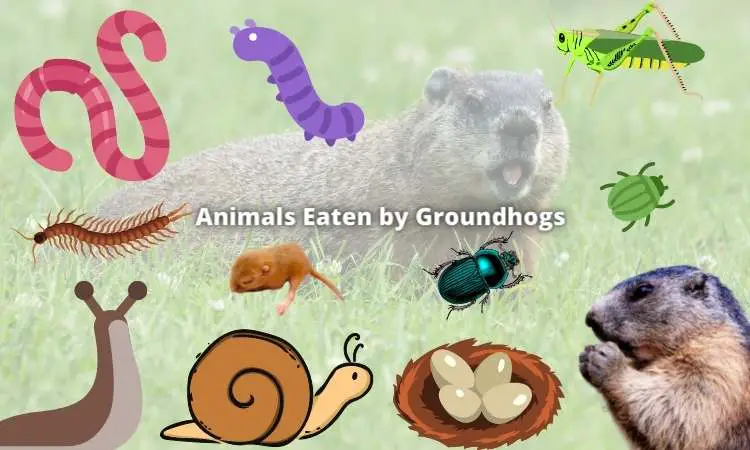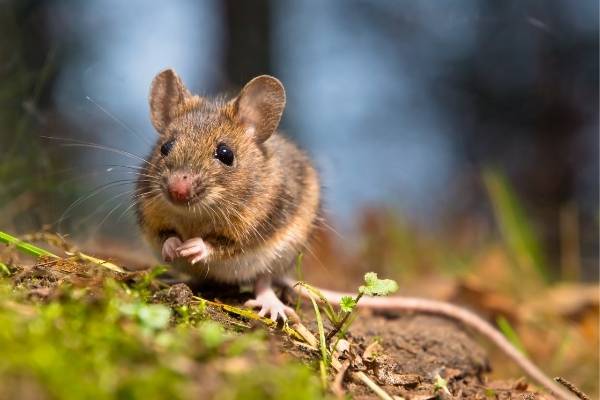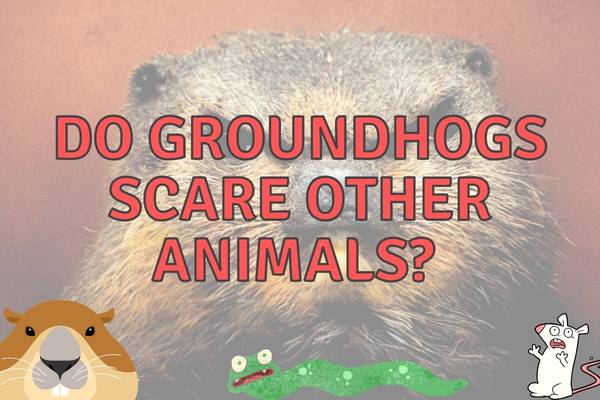The groundhog, also called a woodchuck, is the largest species in the squirrel family. They dig tunnels in the ground for homes, much like a relative of theirs, the gopher, but groundhog tunnels are larger.
One might think that their activity or smells would deter other animals from your yard, but this is not the case. In fact, animals like rats, snakes, mice, moles, voles, raccoons, and skunks, may be attracted to the presence of groundhogs.
Some animals, especially rodents, may benefit from their burrows for protection or eat from their food storage depots in winter.
While they can be a pain when you discover a tunnel opening in your yard, groundhogs prefer living in wooded areas. Some will have one burrow in a grassy place during the summer with a winter burrow safe in the woods so they can hibernate without worry.
Contents
Are groundhogs aggressive?
No, they are not aggressive, preferring to run to a burrow to escape or run out of a burrow if an enemy invades it, but they will defend themselves when necessary, with sharp front claws and their two long front teeth.

They usually mind their own business, intent on raising their young and eating enough to provide enough fat to get through winter hibernation.
While they aren’t a direct threat to other animals, they do have enemies that prey on them, including foxes, wolves, coyotes, dogs, and bobcats.
Groundhogs are herbivores, eating fruit, plants, grasses, and tree bark. They’ll also eat any insects that happen to be on the plants they eat.
Do they attack humans?
Groundhogs are not normally aggressive toward humans. They will make loud noises, sometimes hiss at you, and maybe even try to nip at us if they feel threatened or cornered. But their small teeth usually cannot make a puncture wound that is very deep.
When they are with their children it is important to keep your distance. They can feel territorial and become defensive when their young are nearby.
When they feel that something dangerous is near, they stand on their hind legs and try to get a good look at the potential threat.
Their only real weapon is their mouth, which they use for digging burrows, taking food apart, and warning other animals away.

Groundhogs are not the fierce creatures that we see in stories and movies. They do not attack people unless they feel threatened or if they think you will harm their children. But there is one other type of groundhog that can be very dangerous to humans.
If you live near wooded areas, chances are that you have seen a groundhog at least once in your life. They are usually around during the spring or fall months because that is when they search for food to store up for winter.
Groundhog tunnels are usually not just one tunnel, but a network with several rooms and entrances extending as far as 40 feet. They don’t dig tunnels just to search for food as some animals such as moles do.
Once they have their home constructed, they usually won’t dig any more tunnels. Just because you find a hole or two, it doesn’t mean that you will see many more.
Will Groundhogs Eat Animals?
The only small animals that are regularly eaten by groundhogs are insects such as grasshoppers, worms, and beetles.
When they come across small insects such as grasshoppers they will usually try to catch them and eat them right away.

Groundhogs will usually encounter insects when digging their underground caves. The eggs of ground-dwelling insects are often located very close to the surface of the ground, so a groundhog would have a much easier time catching it than beetles or grasshoppers, and they are nutritious too.
To keep groundhogs out of your home compound or chicken coop, simply put up a fence or barrier that is at least 2 feet tall.
They are pretty good climbers but they cannot climb over something this size. If groundhogs are already living on your property be sure to clean up any fallen fruit around the area.
See my lists of ways to keep groundhogs out of your yard in my previous post here or at the end of this post.
Do groundhogs keep snakes away?
Groundhogs may avoid snakes, but the opposite is not true.
Groundhogs are sometimes thought to eat snakes, but this is not true as they mostly stick to vegetation, although they may eat a baby bird that has fallen from a nest.
Snakes are actually an enemy of groundhogs since snakes can enter a groundhog tunnel and eat baby groundhogs.
While groundhogs are not specifically known for keeping snakes away, their behavior and habitat preferences may indirectly discourage the presence of snakes in certain areas.

These burrows can be quite extensive, with multiple entrances and various chambers for different purposes, including hibernation, nesting, and rearing young. In my years of observing groundhogs, I have noticed that they tend to prefer open areas with a mix of meadows, fields, and woodland edges where they can find ample vegetation to eat.
When it comes to snakes, their presence in an area is influenced by various factors, including food availability, shelter, and temperature. Most snakes are carnivorous and feed on small mammals, birds, and reptiles, among other prey. While groundhogs are not typical prey for snakes, it is possible that snakes may occasionally venture near groundhog burrows in search of other prey or for shelter.
Based on my personal experiences and observations, groundhogs are not natural predators of snakes, nor do they actively seek to keep them away.
However, the burrowing behavior of groundhogs can indirectly affect snakes in a few ways. The extensive tunneling system created by groundhogs can disrupt or destroy the habitats of some snake species that require undisturbed soil or ground cover for nesting or hibernation.
For example, snakes that rely on abandoned mammal burrows for shelter may be deterred by the presence of active groundhog burrows.
Moreover, the aboveground activities of groundhogs, such as their constant grazing and browsing on vegetation, can alter the landscape and vegetation structure. This alteration of the habitat can potentially impact snake populations indirectly.
Some snake species prefer areas with tall grasses or dense vegetation for hunting, camouflage, or protection. I have noticed that groundhog activity often leads to the reduction of tall grasses and the opening up of vegetation, which may make an area less attractive or suitable for certain snake species.
However, it is important to note that snakes are highly adaptable and can occupy a wide range of habitats. I have personally encountered snakes in areas where groundhogs were abundant. Snakes have their own means of finding suitable food sources, shelter, and thermoregulation spots, regardless of the presence or absence of groundhogs. Therefore, while groundhogs may have some influence on the snake habitat indirectly, they do not serve as a consistent or reliable deterrent for snakes.
In conclusion, groundhogs do not have a direct role in keeping snakes away. Although groundhog burrowing and foraging activities may indirectly impact the habitat structure, reducing the suitability for certain snake species, snakes have their own adaptations and behaviors that allow them to thrive in various environments.
So, if you’re concerned about snakes in your area, it is important to consider other factors such as the local ecosystem, habitat features, and snake behavior, rather than relying solely on groundhogs as a solution.
Do groundhogs keep mice away?
Groundhogs and mice generally don’t interact with each other. Since groundhogs eat plants, mice have nothing to fear from them. Neither will keep the other away from an area.

Mice might venture into used groundhog tunnels when abandoned by the groundhog to find their food storage chamber, but so might other smaller rodents like rats, gophers, and rabbits.
Groundhogs are more concerned with finding and consuming plants, such as grasses, clovers, and other greenery, rather than actively hunting or preying upon small rodents like mice.
It’s important to note that groundhogs and mice occupy different ecological niches. Groundhogs are typically found in open grasslands, meadows, and forest edges, where they dig complex burrow systems for shelter and hibernation.
On the other hand, mice are highly adaptable rodents that can thrive in a wide range of habitats, including fields, forests, homes, and even urban environments. Mice are often associated with human dwellings due to their ability to find shelter, food, and water in and around buildings.
While groundhogs and mice may occasionally encounter each other in shared habitats, their interactions are generally neutral or unrelated. Groundhogs are primarily focused on their herbivorous diet, and mice are more concerned with finding sources of food and suitable nesting sites. There is no evidence to suggest that groundhogs actively deter or repel mice through any physical or behavioral means.
However, it’s important to recognize that nature is complex, and various factors can indirectly influence the presence or absence of mice in a given area. For instance, groundhogs create burrows that may provide shelter and resources for other organisms, including mice. Additionally, the presence of predators, such as owls, snakes, and larger mammals, can impact mouse populations by exerting predation pressure. Therefore, the interactions between groundhogs, mice, and their shared environment can be intricate and interconnected.
In conclusion, while groundhogs are fascinating animals with unique ecological roles, they do not serve as natural deterrents for mice. The presence or absence of mice in an area is influenced by a multitude of factors, including habitat suitability, availability of food and water, and the presence of predators.
Therefore, if you are dealing with a mouse infestation or wish to keep mice away, it is advisable to employ appropriate rodent control methods, such as sealing entry points, removing food sources, and implementing traps or other pest management techniques tailored specifically for mice.
Do groundhogs keep rats away?
Like mice, rats and groundhogs just generally ignore each other. However, larger rat species might use an old groundhog burrow to live and nest in.
They also make a great hiding place in an emergency, whatever the rat’s size. Groundhogs aren’t a threat to rats and don’t keep rats away.
Do groundhogs eat rats?
Groundhogs don’t eat rats. Although they have much bigger teeth than rats, and they’re made for digging. Rats’ teeth are so small that they can’t eat through the groundhog’s tough skin.
Groundhogs are known to eat smaller animals like crickets, worms, and beetles on occasion, but they do not eat other rodents.
Do groundhogs keep raccoons away?
Groundhogs and raccoons travel in very different circles. Groundhogs search for plants to eat, while raccoons will eat a wide variety of things, which is why they sometimes get into the garbage. They don’t compete for food.
Besides, groundhogs are active during the day while raccoons are generally up and around at night. Neither is a threat to the other nor do they avoid each other.

Actually, raccoons can benefit from having groundhog neighbors. They find abandoned groundhog tunnels to be really convenient places to raise their young.
Also, while raccoons don’t actually hibernate, when the weather is really cold they will group up to keep each other warm overnight rather than go out hunting, and an old groundhog burrow is perfect for that.
In addition, male raccoons tend to be rather solitary except during mating season and winter. When it’s really cold, a nice, warm groundhog burrow can be the perfect place to wait until the weather warms a bit. They’ll even move into an empty room while the landlord is still living there.
Do groundhogs keep squirrels away?
Groundhogs search for food on the ground, while squirrels get much of their food high in trees. They usually don’t even see each other.
Groundhogs will eat acorns and other seeds and nuts that squirrels also like, but they only get those available on the ground. They don’t endanger each other at all, so squirrels won’t avoid groundhogs.
Do groundhogs keep skunks away?
Unfortunately, they will not. Their food preferences are entirely different, as skunks mostly eat insects and small rodents, getting much of their food by digging small holes. They will also eat insect larvae they dig up, such as grubworms, and eat plenty of other insects and even spiders.
Rather than groundhogs keeping skunks away, the two species can actually get rather chummy. Skunks will use an abandoned groundhog burrow for raising a family or hibernating.
In fact, since groundhog burrows often have more than one room, a skunk will sometimes just move in with a groundhog for the winter if he can’t find an unused burrow, just moving into an empty room.
The groundhogs don’t seem to mind the company if indeed they are even aware of the new tenant.
How to keep groundhogs away from your yard?
Because groundhogs are more likely to attract other animals than repel them, you might want to keep groundhogs away from your yard.
The methods I will go through here will not only keep groundhogs away but also most other rodents or larger pest animals.
Instead of trying to kill groundhogs, I would strongly recommend one of the solutions listed below. They are both effective, cheap, and humane as they just scare away the groundhogs rather than harming them.
1. Motion-activated sprinklers
Like most animals, groundhogs hate surprises, and they will run away if suddenly sprayed with water. I like this solution because it is humane, simple, effective, and does not require much time to set up and there are many models to choose from.
My favorite sprinkler option here is the Havahart 5277.
The Havahart 5277 is a motion-activated sprinkler that is activated by the movement of animals up to 25 feet away and sprays them with a harmless water jet, frightening them off and keeping them at bay.
The included metal stake makes it easy to install in your backyard, and the sprinkler can be rotated 180 degrees for maximum coverage.
2. Ultrasonic Sound Emitters
Groundhogs and groundhogs, as well as other animals that may invade your garden, tend to have very good hearing. This means that loud or consistent noises will scare them away or at least shorten their visits significantly!
One of my favorite technologies to keep pests away from my backyard is these cool solar-powered ultrasonic sound emitters that you can buy right off Amazon! In my experience, they really work, and the solar panels on top save you the time and money of changing batteries all the time.
3. Using Lights and Reflections
Groundhogs are nocturnal animals so they may avoid areas that have bright lights. Motion-activated lights, sounds, and sprinklers may help prevent groundhogs from entering your yard.
Placing CDs or tin foil and mirrors around your yard is another cheap and effective way to create light reflections that blind and scare groundhogs.
This may sound a little old-fashioned but it still works! The reflective surface of CDs or tin foil drives groundhogs crazy and will make them seek away from your plants.
You can use old CDs you no longer need or aluminum trays from takeaway containers, just make sure they reflect light well.
If you have a lot of plants to protect this way, it may be a good idea to invest in some commercial mirrors or electronic light emitters like the ones shown above.
4. Build a Fence
The most obvious and practical solution to protecting your plants from groundhogs is to install a fence around the patch. A fence should be at least 2 feet tall and sunk in the ground about 8 inches.
The best fencing material for this purpose is a cattle panel or hog panel as they are very sturdy and can withstand even quadruped animals such as goats, cows, and deer. However, most chicken fencing types will do. This will be strong enough to stop them from getting through while still allowing for airflow and sunlight.
If you don’t like the idea of building a fence around your entire onion patch then you can try fencing off only the area that your onions, tomatoes, or zucchinis are in; this will at least keep some of the groundhogs or groundhogs away from them.
5. Using Hot Pepper Or Garlic Spray
This is a good way to protect your vegetable plants or decorative flowers against pests such as groundhogs, rabbits, deer, and groundhogs. It will also protect your backyard against the neighbor’s cat that thinks it is fine to use your vegetable garden as a toilet.
You only need about 1 tablespoon of crushed chili pepper and garlic along with 1 cup of vinegar per half a gallon of water.
Spray this mixture on any exposed parts of the plant until completely covered. Make sure you reapply whenever rain washes away the spray.
6. Use Rodent Deterring Companion Plants
Instead of making a tincture out of strongly smelling plants, you can also just plant the plants themselves!
Companion planting is a good way of deterring animals like groundhogs from your garden. You can plant strong-smelling plants such as garlic, basil, lavender, and chives around your favorite vegetables.
These plants will keep rodents like groundhogs, groundhogs, and mice away because they don’t like the smell of these and they mask the smell of the delicious plants.
7. Using Artificial Repellent
You can use some of the commercially available repellents to protect your vegetable plants against groundhogs, groundhogs, and other rodents. You will need to be careful when using these though because some of them can end up harming you and your pets if not applied properly. Some of the commercial groundhog repellents available include Shake-Away, Bonide Repels All, Critter Ridder, and Tom Cate Repellent.
8. Using a Scarecrow
Scarecrows may look a little funny in your garden, but they work surprisingly well. Just make sure your scarecrow is big and scary enough to deter groundhogs from getting anywhere near your tomatoes, zucchini, or backyard flowers! Also, you may need to replace the scarecrow every now and then as groundhogs will get used to it.
9. Using live traps
Using live traps to catch the groundhog and drive it away to somewhere safe, but far away, is perhaps the best option if you want to get completely rid of groundhogs in your yard!
You can make a trap yourself with some wire and ingenuity…
But, you can also just buy a live trap, as the sturdy metal ones shown here:
Conclusion
Groundhogs are interesting animals that are sometimes considered pests, but they do not scare away other pests, unfortunately.
Although they do not keep other animals away from your yard, they can be beneficial for some animals to have around.
Their burrows provide shelter for many animals during harsh weather conditions.





















